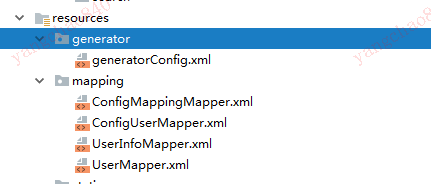SpringBoot整合Mybatis自定義攔截器,實現拼接sql和修改
一、應用場景
1.分頁,如com.github.pagehelper的分頁外掛實現;
2.攔截sql做日誌監控;
3.統一對某些sql進行統一條件拼接,類似於分頁。
二、MyBatis的攔截器簡介
然後我們要知道攔截器攔截什麼樣的物件,攔截物件的什麼行為,什麼時候攔截?
在Mybatis框架中,已經給我們提供了攔截器介面,防止我們改動原始碼來新增行為實現攔截。說到攔截器,不得不提一下,攔截器是通過動態代理對Mybatis加入一些自己的行為。
攔截物件
確立攔截物件範圍:要攔對人,既要保證攔對人,又要保證對正確的人執行正確的攔截動作
攔截地點
在Mybatis的原始碼中
攔截時機
如果mybatis為我們提供了攔截的功能,我們應該在Mybatis執行過程的哪一步攔截更加合適呢?
攔截某個物件幹某件事的時候,攔截的時機要對,過早的攔截會耽誤別人做自己的工作,攔截太晚達不到目的。
Mybatis實際也是一個JDBC執行的過程,只不過被包裝起來了而已,我們要攔截Mybatis的執行,最遲也要在獲取PreparedStatement時攔截:
PreparedStatementstatement=conn.prepareStatement(sql.toString());
在此處偷偷的將sql語句換掉,就可以改變mybatis的執行,加入自己想要的執行行為。
而獲取Mybatis的Statement是在StatementHandler中進行的。
三、程式碼示例
第一步、引入依賴
<dependency> <groupId>org.mybatis.spring.boot</groupId> <artifactId>mybatis-spring-boot-starter</artifactId> <version>1.3.2</version> </dependency>
第二步、配置application.propertities,指定好好對映檔案和實體類的目錄
### mybatis
mybatis.mapperLocations: classpath:mapping/*.xml
###classpath就是應用程式resources的路徑
mybatis.type-aliases-package: com.pingan.yc.demo.model第三步、配置程式碼生成器,引入配置在pom中新增一下程式碼
<build>
<plugins>
<plugin>
<groupId>org.apache.maven.plugins</groupId>
<artifactId>maven-compiler-plugin</artifactId>
<configuration>
<source>1.8</source>
<target>1.8</target>
</configuration>
</plugin>
<!--<plugin>
<groupId>org.apache.maven.plugins</groupId>
<artifactId>maven-resources-plugin</artifactId>
<configuration>
<encoding>${encoding}</encoding>
</configuration>
</plugin>-->
<plugin>
<groupId>org.springframework.boot</groupId>
<artifactId>spring-boot-maven-plugin</artifactId>
</plugin>
<!-- mybatis generator 自動生成程式碼外掛 -->
<plugin>
<groupId>org.mybatis.generator</groupId>
<artifactId>mybatis-generator-maven-plugin</artifactId>
<version>1.3.2</version>
<configuration>
<!-- 自動生成程式碼的配置檔案地址 -->
<configurationFile>${basedir}/src/main/resources/generator/generatorConfig.xml</configurationFile>
<verbose>true</verbose>
<overwrite>true</overwrite>
</configuration>
</plugin>
</plugins>
</build>在resource資料夾下新建generator.xml檔案

內容如下:需要注意配置資料庫連線驅動和資料庫連線,指定生成實體類和對映檔案的路徑,最後按格式配置要生成的資料表
<?xml version="1.0" encoding="UTF-8"?>
<!DOCTYPE generatorConfiguration
PUBLIC "-//mybatis.org//DTD MyBatis Generator Configuration 1.0//EN"
"http://mybatis.org/dtd/mybatis-generator-config_1_0.dtd">
<generatorConfiguration>
<!-- 資料庫驅動:選擇你的本地硬碟上面的資料庫驅動包-->
<classPathEntry location="D:\Users\admin\.m2\repository\mysql\mysql-connector-java\5.1.46\mysql-connector-java-5.1.46.jar"/>
<context id="DB2Tables" targetRuntime="MyBatis3">
<commentGenerator>
<property name="suppressDate" value="true"/>
<!-- 是否去除自動生成的註釋 true:是 : false:否 -->
<property name="suppressAllComments" value="true"/>
</commentGenerator>
<!--資料庫連結URL,使用者名稱、密碼 -->
<jdbcConnection driverClass="com.mysql.jdbc.Driver" connectionURL="jdbc:mysql://localhost:4433/standard_policy_db" userId="dev" password="dev">
</jdbcConnection>
<javaTypeResolver>
<property name="forceBigDecimals" value="false"/>
</javaTypeResolver>
<!-- 生成模型的包名和位置-->
<javaModelGenerator targetPackage="com.pingan.yc.policy.model" targetProject="src/main/java">
<property name="enableSubPackages" value="true"/>
<property name="trimStrings" value="true"/>
</javaModelGenerator>
<!-- 生成對映檔案的包名和位置-->
<sqlMapGenerator targetPackage="mapping" targetProject="src/main/resources">
<property name="enableSubPackages" value="true"/>
</sqlMapGenerator>
<!-- 生成DAO的包名和位置-->
<javaClientGenerator type="XMLMAPPER" targetPackage="com.pingan.yc.policy.dao" targetProject="src/main/java">
<property name="enableSubPackages" value="true"/>
</javaClientGenerator>
<!-- 要生成的表 tableName是資料庫中的表名或檢視名 domainObjectName是實體類名-->
<table tableName="t_user_yc" domainObjectName="User" enableCountByExample="false" enableUpdateByExample="false" enableDeleteByExample="false" />
<table tableName="t_userinfo_yc" domainObjectName="UserInfo" enableCountByExample="false" enableUpdateByExample="false" enableDeleteByExample="false" selectByExampleQueryId="true"/>
</context>
</generatorConfiguration>
最後:在maven命令視窗或如下介面中執行mybatis-generator:generate命令

最後生成如下檔案:

第四步、攔截器
(生成對應檔案後,mybatis環境算是整合好了,可以執行一個測試類試試能否從資料庫讀取資料。)
定義一個類實現Mybatis的Interceptor介面,@Component註解必須要新增,不然可能出現攔截器無效的情況!!!
import org.apache.ibatis.executor.statement.StatementHandler;
import org.apache.ibatis.mapping.BoundSql;
import org.apache.ibatis.mapping.MappedStatement;
import org.apache.ibatis.plugin.*;
import org.apache.ibatis.reflection.DefaultReflectorFactory;
import org.apache.ibatis.reflection.MetaObject;
import org.apache.ibatis.reflection.SystemMetaObject;
import org.springframework.stereotype.Component;
import java.lang.reflect.Field;
import java.lang.reflect.Method;
import java.sql.Connection;
import java.util.Properties;
@Component
@Intercepts({
@Signature(
type = StatementHandler.class, method = "prepare", args = {Connection.class, Integer.class
})
})
public class MySqlInterceptor implements Interceptor {
@Override
public Object intercept(Invocation invocation) throws Throwable {
// 方法一
StatementHandler statementHandler = (StatementHandler) invocation.getTarget();
MetaObject metaObject = MetaObject.forObject(statementHandler, SystemMetaObject.DEFAULT_OBJECT_FACTORY, SystemMetaObject.DEFAULT_OBJECT_WRAPPER_FACTORY, new DefaultReflectorFactory());
//先攔截到RoutingStatementHandler,裡面有個StatementHandler型別的delegate變數,其實現類是BaseStatementHandler,然後就到BaseStatementHandler的成員變數mappedStatement
MappedStatement mappedStatement = (MappedStatement) metaObject.getValue("delegate.mappedStatement");
//id為執行的mapper方法的全路徑名,如com.uv.dao.UserMapper.insertUser
String id = mappedStatement.getId();
//sql語句型別 select、delete、insert、update
String sqlCommandType = mappedStatement.getSqlCommandType().toString();
BoundSql boundSql = statementHandler.getBoundSql();
//獲取到原始sql語句
String sql = boundSql.getSql();
String mSql = sql;
//TODO 修改位置
//註解邏輯判斷 添加註解了才攔截
Class<?> classType = Class.forName(mappedStatement.getId().substring(0, mappedStatement.getId().lastIndexOf(".")));
String mName = mappedStatement.getId().substring(mappedStatement.getId().lastIndexOf(".") + 1, mappedStatement.getId().length());
for (Method method : classType.getDeclaredMethods()) {
if (method.isAnnotationPresent(InterceptAnnotation.class) && mName.equals(method.getName())) {
InterceptAnnotation interceptorAnnotation = method.getAnnotation(InterceptAnnotation.class);
if (interceptorAnnotation.flag()) {
mSql = sql + " limit 2";
}
}
}
//通過反射修改sql語句
Field field = boundSql.getClass().getDeclaredField("sql");
field.setAccessible(true);
field.set(boundSql, mSql);
return invocation.proceed();
}
@Override
public Object plugin(Object target) {
if (target instanceof StatementHandler) {
return Plugin.wrap(target, this);
} else {
return target;
}
}
@Override
public void setProperties(Properties properties) {
}
}此外,定義了一個方法層面的註解,實現區域性指定攔截
@Target({ElementType.METHOD,ElementType.PARAMETER})
@Retention(RetentionPolicy.RUNTIME)
public @interface InterceptAnnotation {
boolean flag() default true;
}最後只需要在指定的方法出添加註解就可以實現區域性攔截

最後執行看結果就好了。(按我的邏輯下來會只查到2條資料)
在@Interceptor的註解中也有以下的註解方式,究竟有什麼不同和差異,請大家自己研究咯,我就在此拋磚引玉了,請各位大牛指導了。
@Intercepts(value = {
@Signature(type = Executor.class,
method = "update",
args = {MappedStatement.class, Object.class}),
@Signature(type = Executor.class,
method = "query",
args = {MappedStatement.class, Object.class, RowBounds.class, ResultHandler.class,
CacheKey.class, BoundSql.class}),
@Signature(type = Executor.class,
method = "query",
args = {MappedStatement.class, Object.class, RowBounds.class, ResultHandler.class})})
